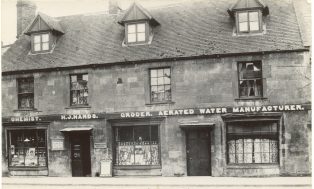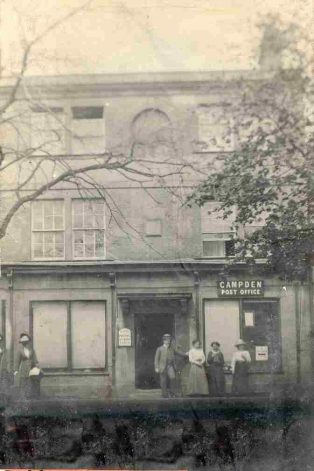A view of Campden at the turn of the 20th century
Dorrie Ellis
Situated as it is geographically, in a fold of the North Cotswolds, overlooking the Vales, Chipping Campden (or Campden as it is known to the locals) has always had to be self-sufficient. All access to it is up or down steep inclines and hard going in the days of real horse power especially on the rough, stony and dusty roads.
The main trade in early days was wool and consequently no shortage of meat for the inhabitants, especially with a pig in the backyard. Garden produce was always available from working the land – but other necessary commodities, depending on horse and cart transport from towns in the Vale were scarce – hence the necessity of providing them “on the spot”.
At the end of the last century, there were four butchers in the town, slaughtering their own meat on the premises, and a pig killer visiting households to help with the killing of the family pet! There was a chemist, who at that time served as a “bank” – that is, a safe in the back premises where tradesmen could deposit any cash takings in safety overnight. There were about six premises baking bread and cakes and doing great trade to provide hunks of bread to go with the cheese and lard for a labourer’s midday snack. Liquid refreshment was a great necessity and most cottagers made their own brew of ale or wine and any excess to their own requirements were sold or bartered to neighbours – licencing laws would be recognised by the six or eight pubs then in existence, but probably didn’t bother the individual householder.
There were two main grocery stores, and the bakers would stock various necessities such as sugar and flour, although many householders had, along with their back gardens or allotments, a plot of land on the outskirts where they would grow wheat or barley to be ground at one of the three local mills – Westington, Haydon’s or Berrington, in order to bake their own bread.
In 1880 Mr. H. Neve, relative of the Horne family from Kingston, opened a Post Office at London House (on the top side behind the War Memorial) and also sold drapery and haberdashery, employing an assistant. There were four blacksmiths, though the nearest wheelwright (for the making of carts) was at Paxford or Blockley – probably because of the difficulty of getting heavy timber up the hills to Campden. A deal of the heavy timber came from the Harrowby Estate at Burnt Norton and when a load was on its way to Blockley via Campden it was quite an event to watch the team of horses dragging the timber wagon along Aston Road to stop at the water trough at Back Ends corner.
There is no recorded memory of dressmakers locally but its certain that most garments were made in the home with material bought at the door from travelling salesmen, and nuns at the convent were instrumental in encouraging school girls to sew and embroider and there are instances of girls being sent to a residential convent in Taunton to learn embroidery. However there was a tailor with a shop in the High Street – Mr. Symes. There was a saddler and harness maker, who also mended shoes and old Joe Hands would mend and also make boots if called upon though most of the shoe mending was the job of the men of the household who would keep a “last” in the garden shed.
Barbers were available, working in front rooms on a skill probably learnt in the Army – but no ladies hairdresser until the 30s. Newspapers were available at small cottage shops after the turn of the century and could be delivered door to door on payment. Mrs. Howell’s small shop in Church Street also had a few books on loan – a library, indeed! – but the books loaned to the girls had to be vetted by Mrs. Howell in case they were ‘unsuitable’!
We have recorded memories of the many cottages up and down the High Street selling sweets and household necessities such as matches (or lucifers as they were sometimes called), candles, soap and paraffin, which must have arrived in the area by carrier – anything to bring in a few pence to augment a labourer’s wages.
The old Market Hall had long been disused, but a monthly excitement was the cattle market held in the Square where livestock deals were made and the numerous pubs were kept busy.
Even up to W.W.2. milk was delivered by pony and trap, churn and jug to cottages from the four active dairy farms in the Campden area and was also available at the farm door. A favourite milk product in the spring was collected from the farm in a basin and was known as “cherry curds” being the first milking from a calving cow and baked in the oven with a sprinkling of nutmeg, similar to an egg custard.
There was a good supply of stonemasons and ‘brickies’ – Cotswold stone quarried at Westington – luckily transported downhill! – and bricks obtainable at the local Blockley Brickworks. Not a great deal of building in the latter part of the l9th century, but escalated when transport became easier.
After W.W.1. and the advent of mechanisation, the first commercial garage opened at the rear of the Noel Arms Hotel, the beginning of Cutts & Co. Two more garages followed and so Campden’s trade scene changed and the cottage shops slowly diminished. The motor car brought visitors to the hotels that opened and garden and allotment produce was sent for sale to Evesham and Stratford markets. Goods from outside became more accessible with outside breweries delivering, a clothes stall from the Bon Marché at Evesham opening once a week at the back of the Eight Bells, an oil man calling at most doors and a monthly second-hand furniture sale in the Town Hall conducted by Mr. Bower, the local auctioneer and known as “Wales Sales” – a great event!
But the advent of tourism and the super-markets after W.W.2. brought complete change and traders from outside moved in to serve a floating selection of customers. Residential properties were changed into gift shops and galleries and most of the old family businesses folded. We entered the twenty first century with Greek and Italian restaurants, a Chinese take-away, jewellers and a beauty therapist!












No Comments
Add a comment about this page